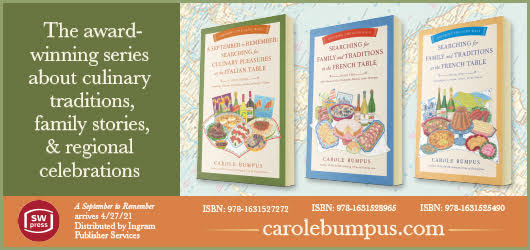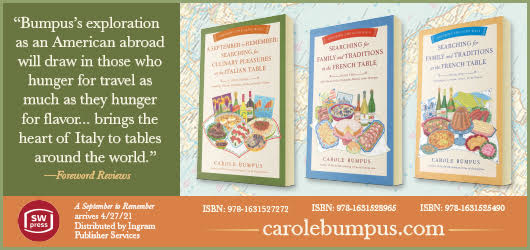Reviewer Melissa Wuske Interviews Carole Bumpus, Author of A September to Remember: Searching for Culinary Pleasures at the Italian Table
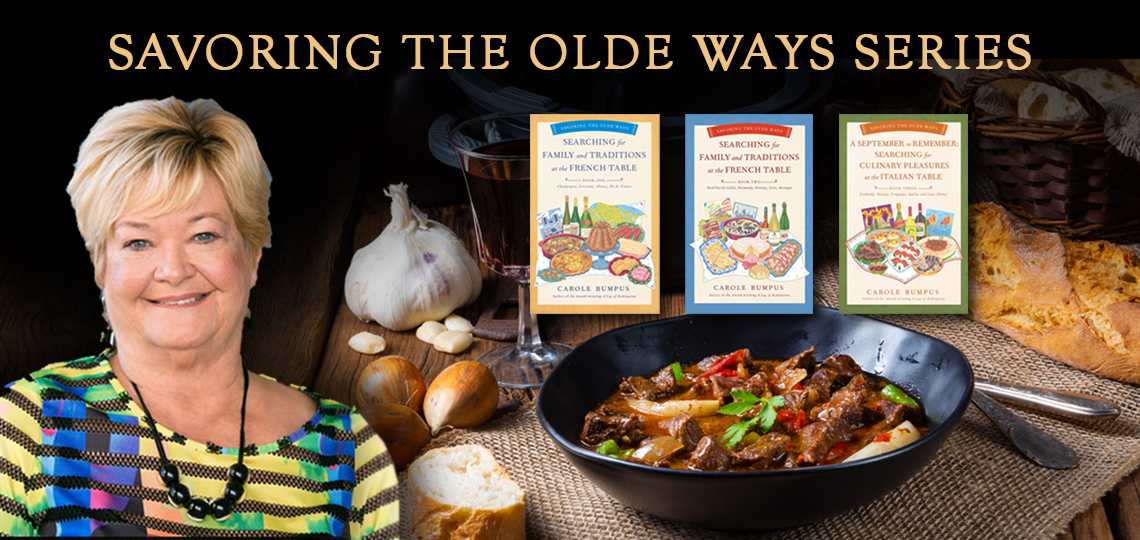
The author of two other books in the Savoring the Olde Ways series—Searching for Family and Traditions at the French Table, Books One and Two—Carole Bumpus knows her way around a kitchen, and a culture—with a nicely paired glass of wine in hand. But don’t hold that against her. She’s put in the work, and you won’t find a more personable literary companion.
So, we’re especially excited to follow her to our favorite country by the wine dark sea: Italia. Her recently released A September to Remember: Searching for Culinary Pleasures at the Italian Table provides the perfect foodie-travel nudge we longed for as the COVID restrictions begin to lift. Inspired by her review of the new title in the March/April issue of Foreword Reviews, we asked Melissa Wuske to reach out to Carole to talk about travel and the irreplaceable role of food and tradition in Italy.
Your books present the inextricable link between food and culture. What’s surprised you as you explored this connection in other cultures?
When my husband and I first began to travel abroad, we, like so many Americans, expected to find different but vaguely familiar cultures wherever we went. Yes, there would be a few substantive distinctions, like language, but quite honestly, the integral connection between food and culture wasn’t on my radar. In fact, it wasn’t until I began asking questions of the locals about their favorite foods as a child, or the special recipes handed down through the generations, or their most beloved holidays, that I realized a connection between culture and traditional foods.
I quickly realized everyone is eager to share memories of their favorite childhood foods and holidays. In fact, the questions almost always elicited excited responses of what they ate. If, for instance, I asked what traditions were observed at Easter, they might shrug their shoulders and say, “We celebrate like everyone else.” But, once I pressed for details, I found the celebrations were rarely the same. The regional traditions along with the specific foods enjoyed would predict what took place during an Easter holiday and what region or country they were from. In the Alsace, for instance, people would dye hardboiled eggs wrapped with straw and leaves to create colorful designs and would hide the eggs and chocolate goodies outside in a large nest on Easter Eve. They would almost always have a lamb-shaped cake, called a Hammele, along with a leg of lamb as the centerpiece of the feast. Some might attend church and others might carry on the Christian traditions as if they had been to church. But no matter, the purpose was the same. A time to gather the family together was always at the heart and soul of every holiday and celebration.
In Abruzzo, deep in the heart of the Italian Apennines Mountains, ancient rituals are still performed each Easter which take place over a four-day period—part Christian, part pagan. The death of Christ is metaphorically experienced by each individual who attends the funereal parades. Then on Easter morning, young men in costume can be seen racing through the streets with large statues of both Mary and Jesus hoisted high on plinths as the words “Christ is Risen” is cried out through the crowds. Tears of joy stain the cheeks of all who attend but is followed by a final parade of (almost) the entire community dressed in their finest honorary robes. Ah, but the rest of the day is given over to the feasting and celebration with families. The standard list of foods prepared especially for Easter and Easter Monday is extensive and expected.
Throughout most of Europe, all one has to do is mention a holiday, or a saints day, and immediately a specific food attached to the event is called out. In the Lorraine, for instance, Chandeleur was mentioned as a favorite holiday. “Why,” I asked. “What does Chandeleur, the Festival of Light, mean to you and your family? How do you celebrate?” Again, shrugs were given, and Gallic puffs emitted as each one looked to the other. Laughingly, they would all shout, “Crêpes!” And then a raucous recounting of how the family would come together each year for the contests held in the family kitchen, called “flipping of the crêpes.” The goal, I was told, was, with one hand gripping the crêpe pan, flip the crêpes high into the air without sticking it to the ceiling, then catching it back in the pan while holding a gold coin in the other hand. “What did this mean?” I asked. “Good luck for the entire year,” came the automatic reply.
There are so many lovely examples I could share with you, but to answer your initial question about the “inextricable link between food and culture,” I found it revealed the traditions the people share with their families. And the importance of family is paramount.
In what ways has some of American culture ignored or severed this link?
I discovered in my family therapy practice that many American families struggle to make ends meet by having both parents working. But often the needs of the children within the family are not easily met. The stresses and strains of every day demands wear on each member of the family. It’s not that this was desirable; they, too, wanted family time together. The dream of sitting down together at the table each night was one they held close to their hearts.
But the infrastructure of families in the US is quite different. Many have chosen to live far away from extended family (or their support system) in order to obtain a better job, or more prosperous way of life. But the interconnectivity within the everyday lives of their families has been lost. Young families struggle to make it on their own without this familial support. That loss permeates the relationships their children have with others, especially with their elders. In fact, they really don’t know them.
A few years back, I interviewed three generations of a family in Umbria, outside of Assisi. I remember asking their college-age son if he lived at home or at college, as I knew he was attending a local university. (I was reflecting on our US teens who couldn’t wait to be away from home.) Their answer set me back. “He lives here at home now but let me tell you why. A number of years ago, our teens couldn’t wait to move away to attend college and make their own lives. But times became financially difficult. It was hard to support our students, so our teens were forced to return home. But what we found was that the family was much happier to be living once again under the same roof. And when the recession lifted, we decided that the arrangement we enjoyed with the family was our gift.”
I must say, the love and connection between all three generations was a beautiful thing to observe and the work they shared—whether it was working in the vineyards, pressing the olives for oil, making daily pasta, or running the agriturismo they owned, they all worked together. Yes, the students still attended classes, but at nearby colleges. And they never missed a nighttime meal together with the family. (Which was a four-hour orgasmic feast, I must report).
I also found that families across Europe who had experienced World War II on their own doorsteps continued to hold their families close to them. The incredible loss of life almost eighty years ago still resonates through each and every generation. (I wrote my first novel about this very dynamic, A Cup of Redemption).
This experience was something we, in the US, don’t understand as the war was not fought here on our soil. Yes, we experienced terrible losses, but most of those happened far away and were rarely revealed except in the last ten to fifteen years as the veterans have begun to open up. “War was hell,” they would say. (While doing research for the novel, I traveled twice with US WWII veterans and their families to celebrate their liberation tours for the 65th and 70th anniversaries of landing on the southern beaches of France—not Normandy, but Nice—an experience that was incomparable. And many of their stories have yet to be fully written.)
It’s clear that your travels and the people you’ve met have changed you. What are some of the lessons and experiences you’re most grateful for?
First of all, one of the important lessons I learned about travel is to make a connection with the locals in the communities I visit. I traveled with either friends or connected with local guides who introduced me to the families I interviewed along with explaining the history and culture of the area. They are the link to the “real experience” of enjoying a country. This is not always easy, but if your goal for the trip is to have a fuller understanding of the people and their culture, this is imperative. I found these personal connections made my experiences deeper, more profound, and much richer.
As an example, many people from the US visiting a restaurant in Paris expect an air of arrogance from the waiters. If you make an effort to speak to the waiters in their own language (or at least make an attempt), ask them for their recommendations on the menu, then about their own favorite foods. You will be surprised by the response. My husband and I had an extraordinary experience not so long ago in one of Alan Ducasse’s restaurants, Le Dali on Rue du Rivoli. Because my interest is in traditional cuisine, I asked some of our waiters about their own food experience and what foods their mothers prepared at home. Eagerly, they ended up telling stories about their mothers’ home cooking and we were enriched by their memories and experiences.
I also learned that once you are invited into a family home, you become a valued guest and the hospitality cannot be matched. The convivial nature that ensues, along with the amount of Champagne consumed, leads to camaraderie that can last a lifetime. And that’s even if you do not understand the language well. (It helps to have a friend translate along the way.)
Another lesson that I appreciated, I learned while in Italy and is part of this book, A September to Remember. The lesson was on the importance of traditions in a culture and how it seems to define the local society. I’ll share an excerpt from chapter nine:
“So, Lisa,” I asked, as I placed antipasto of melon and prosciutto before her, “how are Italian families different from our own families in the States?”
Lisa, our Italian host, my husband, Winston, and I had spent the day leisurely walking around the town of Poderi di Montemerano, Tuscany, down to the post office, through the hillsides of harvested grapes, and back home. To continue our conversation, we invited her for dinner that evening, and I had tried my hand at cooking Italiano.
“Excellent question,” she said in a rather school-teacherly fashion, “as your question goes to the heart of all of their traditions—their Italian traditions! This is a detail—this understanding of the traditions—is what we all need to really pay attention to, or we will miss it.” She picked up her wine glass, swirled the rosy liquid in slow motion, then set it down again without drinking.
“Perhaps,” she said, after contemplation, “I noticed the differences in this Italian culture for the first time when I was a student in Florence, and then again as the young wife of a Roman. But I found it’s right there when you are present in those moments.” She paused. “And it’s not there when … well, it’s difficult to describe.”
“Sounds like you are about to tell us the secret of the universe and everything in it,” my husband, Win, said with a grin, paraphrasing one of his favorite authors, Douglas Adams. He stuffed his napkin into his shirt collar and smoothed it down over his chest.
“Well, it’s not all that serious,” she smiled, “but let me back up. There is a very precise schedule to things in Italy, and everyone observes that schedule—even the Parliament stops at 1:00 o’clock and they go off to lunch and enjoy a full primo and secondo—nothing more, nothing less. It’s something about order, I think. It’s sort of a classical thing. Here in Italy people have a precise schedule within their lives that determines when they do things. And it’s not just a daily schedule, but a yearly schedule, too. For instance, you eat only seasonal vegetables during that season. No other time. And you are, of course, doing this with all your family. So, when I say there is a rigor to it, it’s through their schedule—it’s a kind of grid of things and everything fits into that grid. It’s not the Anglo-Saxon way of handling things—that’s for certain!”
“What exactly do you mean?” I was eager to understand.
“For instance, in the States, you are always rushing to get somewhere, then you go through the motion of doing what you came to do, then you relax! Aaah! But then you rush to do the next thing, just to get through it, and it is all so stressful! Do you understand what I mean?”
My husband and I nodded our heads. Yes, we understood. We were worn to the nubbin from doing just that at home, and that was why we had raced to Tuscany for our vacation. She had nailed our American cultural model to the wall.
“Why does this stress not exist in the Mediterranean?” she asked us. We blinked but had no answers.
She continued “There is something about flow in the Mediterranean that is always present. It is characteristic of the people and I must say, in a guarded kind of judgment, I think it really is the Mediterranean people.” Her fingers thumped against the table as she contemplated this further.
“Perhaps it’s the geo-psychological origins from a long, long time ago—from the Phoenicians or from the Etruscans. All people from around the Mediterranean are one. They have a shared culture—like a, like a psychology of place.”
Geo-psychological origins? The terms rolled through my thoughts as I tried to make sense of them. Is there a psychology of place? Is that what she means? I had only a small inkling of what this might convey, but I was eager to learn.
“So, you’re saying the so-called grid or ‘schedule’ that was culturally set up here eons ago, is what sets everything into its place now?” I asked. She nodded.
“So, is it like a characteristic that some geographic places have, and some do not? Or a feeling or perception people hold? I asked her again.
“Yes. It might be the Mediterranean people’s connection to the solar part of them—the sun and the seasons. Or it might be the sea part of them—the tides, the ebb and flow that connects them to the Earth.”
“Ah, now that must be the answer,” Win, the sailor, said with a confident air. He sat back in his seat as if all pieces of this mental puzzle had ebbed and flowed into a comfortable mooring.
Lisa smiled kindly. “Yes, I’m thinking that might be part of the answer. It’s all very powerful, and without words it roots each person, each Mediterranean being, to what is, and to what is good.”
What’s the most unforgettable meal you’ve had at someone else’s table?
What immediately comes to mind is the Festa di Poderi di Montemerano. Again, I’ll describe this life-altering experience through an excerpt. It was this meal that sent me in search of cucina povera or peasant foods in every country I visited. I have never been the same since. From chapter two:
Then, like lava flowing down a mountain, the crowd began to surge along the stone roadway with us caught in the current. All were moving toward the festival grounds at the bottom of the hill. Smoke from the pits of braising meats tantalized us, along with the intoxicating aromas of simmering pasta sauces. The crowd turned toward the ticket booths, and the excitement grew. Music, laughter, and the banter of their melodious language filled the air. Lisa recited the menu to us in English in the most delectable detail. We hungrily placed our orders.
Another push from the crowd propelled us into nearby tents, where we were again greeted with hugs and kisses by those who were already glowing with amiability and wine. Lisa wedged us into the two remaining spaces beside her in the middle of a long table of twenty or more of her closest friends. We had barely been seated when a trumpet sounded, and the feast began. The doors to the kitchen flew open and local waiters proceeded in great numbers to the tables, carrying plates of bruschetta—toasted bread slathered with rich, local olive oil, chopped fresh tomatoes, and succulent olives. One simple bite brought tears of joy to my eyes. The savory yet mellow flavors danced through my mouth. Bottle after bottle of local wine began to magically appear—some from the kitchen and some from under the table.
Again, the waiters swung out of the kitchen. For the prima piatti, or first course, platters of fresh pasta were served. Plates of tortoni, Poderi’s local pasta specialty—delicate pillows filled with cheese and arugula and covered with a bubbling, robust marinara sauce —were reverentially placed before us. The masses swooned with appreciation, and we joined their ranks.
Lisa leaned over and whispered, “I had to live here over twenty years before the older women of Poderi allowed me into the kitchen to help prepare their beloved tortoni. Yes, I could come and help at the Festa, but prepare the tortoni? Heavens, no. And the recipe? Don’t even ask! It is still a much-guarded secret.” She laughed with great delight.
Cecilia, who had been reserved until then, leaned over the table and shouted, “They’d perhaps have to keel you if you got your hands on the recipe.” She grinned and sat back as handmade gnocchi with meat sauce and pasta e fagioli were whisked to their designated places along with baskets of Tuscan bread to sop up any lingering juices.
For our secondo piatti, or second course, sizzling grilled meats of beefsteak, pork, chicken, or sausages, all on spears, were passed down the tables. Then, contorni, (vegetable side dishes) of white beans, fried potatoes, and mixed green salads followed the meats. Gasp!
Filled to the brim, we all leaned back to gather our collective breath, but to no avail. We were next tempted with formaggio, the cheese course. And the finale was the dolci—dessert—presented with a majestic flourish. Lisa whispered over the tumult surrounding us, “You are to choose either a Salame cioccolata or a Mousse di ricotta.” We moaned with delight, though we had no idea what either contained.
“Ah,” she echoed our moan, “Mousse di ricotta is sweet, creamy custard made by my dear neighbor, Margarita.” She pointed across the table to her kindly-looking, blue-eyed friend from Germany, whom we had met earlier. Margarita nodded politely.
“Margarita made this dessert this morning using seventy-two eggs! Can you imagine that? Seventy-two eggs to make her most delectable Mousse di ricotta! And the Salame is not a sausage at all, but a rolled cookie filled with chocolate cream. This was prepared by dear Amelia,” she said pointing to a petite, gnarled elderly woman waving to us at from the far end of the table. Of course, we tried a little of each; we had to. Each was delicate, light, and almost floated off our tongues.
“Mmm,” I swooned, as wine was poured into my cup, as it had been throughout the meal. Like magic, as one bottle emptied, another would pop into its place.
And what’s the most unforgettable meal you’ve hosted?
I still have the menu I printed for each of the twelve guests. At the time, I thought this was quite grand.
Cheese Dish with Candied Chipotle Peppers
Champagne
***********
Crab Cakes with Roasted Red Pepper Aioli
Pear and Roquefort Cheese Salad
Chardonnay
*********
Chicken Fricassee with Roasted Red Peppers and Creamy Polenta
Roasted Asparagus with Prosciutto
Cabernet Sauvignon
***********
White Chocolate Mousse with Raspberry Sauce
Framboise Liqueur and/or Limoncello
Hazelnut Coffee
Cooking isn’t your professional background. How did you end up in this niche?
About the same time, I retired and took up world travel, I also began taking cooking classes at a local cooking school. I wanted to learn how to prepare some of the traditional dishes I had tasted in Italy and France. When chef and owner, Sharon Shipley, invited a group of twelve of us to accompany her to Provençe on a ten-day gourmet cooking tour, I was certainly ripe for the picking and fell in love with not only the dishes we learned throughout Provençe but also the ancient history that each recipe conveyed.
Following this glorious tour, Sharon invited me to join her in both Italy and France to set up future cooking tours. I immediately accepted the prospect and was introduced to chefs, restaurateurs, cookbook authors, and food writers from all over the world and also was able to interview families in all the different regions we traveled. It was an incredible gift, and it was at this time I decided I wanted to write the series Savoring the Olde Ways. So, it began.
What advice do you have for those who love travel and eating but feel a bit intimidated by cooking?
If your goal is to try your hand at cooking local dishes, enroll in a cooking class here at home and later while abroad. There are many classes available and for all levels of culinary experience. My husband and I have taken cooking classes here in the States and also in Florence, Bordeaux, Barcelona, Melbourne, plus classes in Turkey, Greece, Switzerland, and Sweden, oh my! Some of these were on cruise ships and most were considered wine/food pairing experiences, as we do love wine. Recently, my husband and I taught a cooking class on Zoom where we prepared fresh homemade pasta and Saltimbocca (recipes from this latest book).
Many people love travel and food, but have trouble getting beyond tourist traps to actually engage in culture. What tips do you have for travelers looking to learn as they go?
I think one of the wisest first steps for travel is to make a list of your interests along with the places (museums, restaurants, monuments, etc.) you wish to visit in each country. Do your research. If your interests are culinary or food/wine related, there are many ways you can schedule or reserve those special events ahead of time. On one occasion my husband and I had reservations to tour the magnificent Sydney Opera House (Australia). Along with the tour, we were treated to a pre-opera dinner of local cuisine tastings which featured a three-foot-tall-tiered tray of amuse bouche from each of the numerous kitchens housed at the Opera House. This was not only a spectacular meal, but we became a spectacle in our own right and at our own table. It was quite amazing!
As for trying to avoid tourist traps, again do your research and work with reputable travel guides and agents. Be clear as to what you want to do or see—or taste! The world is more than just your “oyster.”
The books in the Savoring the Olde Ways series have taken readers along in your travels to Italy and France. Where do you hope to travel (and eat!) next?
As you can tell, I have loved traveling abroad and have completed many interviews which have yet to be developed into books. I still have material for at least two or more books just on Italy. And I have yet to write the book about the culinary pleasures of Provençe or around Bordeaux. And, then there is writing about the culinary/wine river cruises we have taken in France and Portugal. Then, there’s Spain … Oh, my! I must get busy!
A SEPTEMBER TO REMEMBER
SEARCHING FOR CULINARY PLEASURES AT THE ITALIAN TABLE
Carole Bumpus She Writes Press (Apr 27, 2021) Softcover $16.95 (245pp)
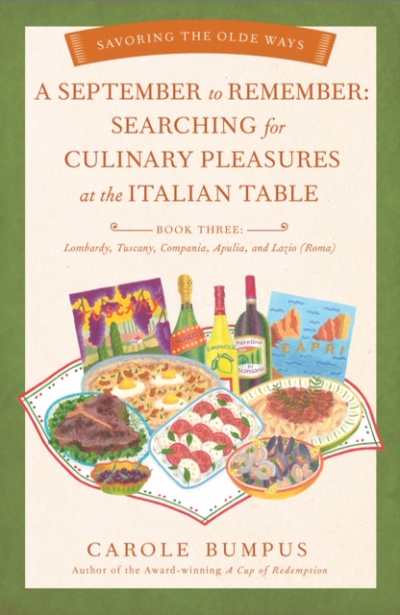
Carole Bumpus’s culinary travelogue A September to Remember is written in the inviting voice of a learner. Bumpus’s exploration as an American abroad will draw in those who hunger for travel as much as they hunger for flavor.
For Bumpus, appreciating food requires a strong sense of people and place; in fact, she regards food and culture as inseparable. Her initial encounters with Italy began when she had very little sense of its language, but had a basic appreciation of its food, and a deep desire to learn the culture from the people she met. Her interest in learning about the culture and its cooking is the central, engaging element of her book. Her narration is open-minded and inquisitive, respectful and humble—and open-handed with all that’s she’s learned.
The book is organized by region, covering Lombardy, Tuscany, Campania, Apulia, and Lazio. Each section includes several chapters of travelogue, with a recipe per chapter at the end of the book. The narrative elements are strong, featuring well-paced scenes, real-life characters, and informative dialogue that harnesses the beauty of the two languages Bumpus engaged in, and reveals the challenges of cross-cultural communication.
The recipes include basics like Homemade Gnocchi; meat dishes like Bistecca alla Fiorentina (porterhouse steak, Florence style); desserts like tiramisu; and, of course, pasta dishes, like Orecchiette con Cime de Rapa (ear-shaped pasta with broccoli rabe). Their instructions are easy to follow for confident home cooks, with clear ingredient lists of items readily available outside of Italy, and thorough instructions. While some elements are simplified for typical American cooks, there are no shortcuts; Bumpus embraces authenticity over simplicity, encouraging cooks to rise to the challenge.
A September to Remember is a food narrative that brings the heart of Italy to tables around the world.
Reviewed by Melissa Wuske March / April 2021
SEARCHING FOR FAMILY AND TRADITIONS AT THE FRENCH TABLE: BOOK TWO
SAVORING THE OLDE WAYS SERIES
Carole Bumpus She Writes Press (Aug 18, 2020) Softcover $16.95 (376pp) 978-1-63152-896-5
2020 INDIES Finalist Finalist, Travel (Adult Nonfiction)
Clarion Rating: 5 out of 5
Carole Bumpus’s Searching for Family and Traditions at the French Table: Book Two is a culinary travelogue of French proportions.
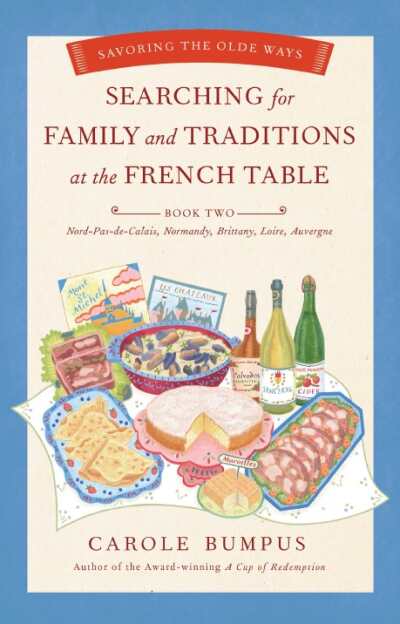
Picking up from where the first book ended, Bumpus continues moving through France to write about families, food, and traditional values. She and Josiane head down the Champs Elysées, past the Arc de Triomphe, and onto the motorway that sweeps them north. They travel through Nord-Pas-de-Calais, Normandy, Brittany, the Loire Valley, and Auvergne, meeting with a variety of memorable people as they taste and discover traditional recipes and unravel the mystery surrounding Josiane’s family history.
Bumpus’s prose is lyrical, conveying the romance of France in each location, interview, and observation. As the pair drives along the A16 through the open countryside, morning light dances across kilometers of bright yellow canola fields. In Brittany, both Bumpus and Josiane experience a feeling that is as inexplicable as the task of “attempting to separate the color blue from water.” While driving through the Loire Valley, en route to a troglodyte cave and a truffle farm, Bumpus rolls down the window to hear the call of a redwing blackbird and observes a mélange of vineyards wherein rows of vines appear to be marching like soldiers up the slope.
Bumpus’s attention to detail creates a rich sense of people and places. The Gallic “puff,” which is best described as a puff of air emitted from the mouth, becomes shorthand for moments when words fail. On other occasions, there is no substitute for the charming French phrases, including “kenavo, au revoir,” meaning “goodbye for now.” While dining in a hotel in the Loire, the mustard-yellow provincial wallpaper and damask curtains are as sumptuous as the sophisticated food that is served.
The food that Bumpus tastes and writes about is unforgettable, thanks to the array of included recipes with unusual names. In Le Havre, Bumpus learns that a mirror egg is another word for sunny-side up, and woofs down a soufflé-like omelet, prepared in a long-handled copper pan, at Mother Poulard’s in Mont Michel. The stereotypical creme brûlée has much competition in Crémets d’Anjou, a soft cream pudding that is ringed with fresh strawberries, and Apples in a Nightdress, an apple pastry consumed at breakfast.
In among the geography, history, and food are human stories of belonging and connection. Louisette, an Algerian refugee living in Rouen, recounts how she was not permitted to take any belongings when she fled, but managed to collect treasures from her former life in the years that followed. In another interview, M. Barreaux refers to September 11, 2001, as the moment he realized that “we are all from the same family—humanity.” When the mystery surrounding Josiane’s family tree is unravelled, Bumpus affirms that the search for identity is a “haunting, but human desire.”
Eloquent and packed with history, geography, and recipes, Searching for Family and Traditions at the French Table: Book Two is a melting pot text––a travel memoir that’s concerned with cuisine and culture, too.
Reviewed by Bianca Bowers June 29, 2020
SEARCHING FOR FAMILY AND TRADITIONS AT THE FRENCH TABLE, BOOK ONE
Carole Bumpus She Writes Press (Aug 27, 2019) Softcover $16.95 (256pp) 978-1-63152-549-0
In Searching for Family and Traditions at the French Table, Carole Bumpus trips through four regions of France. Part culinary memoir, part travelogue, the book shares intimate portraits of three generations of French families whose homes Bumpus was invited into. She imparts the families’ histories (often set against the backdrops of WWI and WWII), local traditions, foods, wines, and drinks, her text capturing a culture at once old and modern.
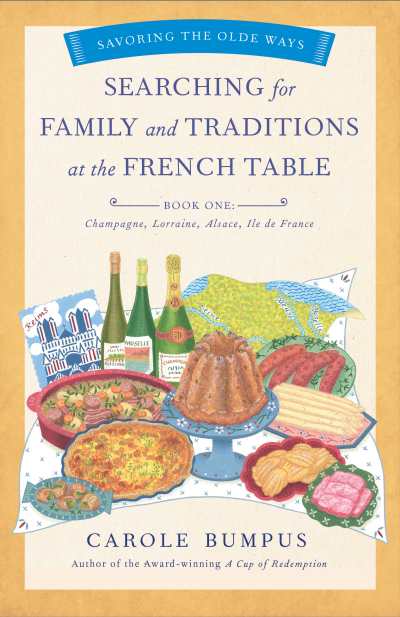
Beginning her tour in Paris––with her husband, Winston; her “French friend from California,” Josiane; and Jean-Claude, one of her many connections in France—Bumpus is told that, for the French, identity is all about history. Her host lays the foundation for her travels, lifting his glass and toasting: “Life is worth living, and if you can recognize the value of each pleasurable moment, you are truly a winner.” This sentiment is echoed throughout her tour: in toasts, traditional celebrations, and simple family gatherings.
Bumpus traveled east to Champagne, then to Alsace, Lorraine, and back to Paris. She ate, drank, and listened to reminiscences and poignant stories that contextualized the French people and their unique place in history. In both Alsace and Lorraine, she was confronted with the hardships left by the wars and their lingering effects on the local culture. The text reflects France’s contentious relationship with Germany, including how the two regions would flip between being German and then French again post-conflicts.
The book is peppered with descriptions of regional and family dishes, with recipes for dishes like Alsatian Baekofe, Crepes, Ravioli Faris au Cresson, and Tarte Flambe included as an added bonus. Searching for Family and Traditions at the French Table is a wonderful ride through four regions of France, generating great excitement for its follow-up.
Reviewed by Eric Patterson September / October 2019
Melissa Wuske

